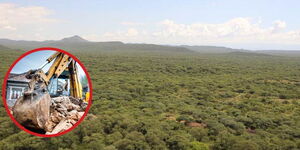The Maasai Mara's most famous lion, Lolparpit (big hair), sent out his final roar on November 18, bringing an end to his 15-year-reign in the vast and iconic game reserve.
He died of natural causes with the body being discovered by a tour driver on the edges of Lolparpit's vast territory.
The 'King' was eulogised by several conservationists, "Who remembers Lolparpit, the king of Masai Mara and one of the oldest male lions in the Mara? He is no more. This mighty guy was named "Lolparpit" which means Big Hair. We will surely miss his actions and shows," a group tweeted.
The legendary Lolparpit and his brother Olbarnoti were born into the Ridge Pride beginning of 2005 along with another male called Junior (from a different female). There were 2 other males born into this pride end of 2003 (Cheza) and mid 2004 (Sala). The latter became famous due to the Big Cat Diary BBC Documentary.
Towards the end of 2007, all 5 males took over the Olkiombo Pride. It took them some time to be accepted by the females and only 3 males stayed with the pride - Cheza, Sala and Junior. Olbarnoti and Lolparpit moved on.
In the course of 2008 they took over a new pride that had settled down in the northwestern part of the Olare Orok Conservancy, the Enkoyonai Pride.
In Mid 2010, they chased out the 2 old Moniko Males (Mzee and Lolalai) and took over the Moniko Pride, these effectively meant the 2 brothers controlled the entire Olare Orok Conservancy until mid-2011.
After having had several confrontations with the Double Crossing/Ridge Pride Males (Olchorre and Naengop) Olbarnoti & Lolparpit gave up on the Enkoyonai Pride while the two Ridge Pride Males left the Double Crossing Pride and took over.
At the end of 2012, two other males took over the Double Crossing Pride, Mohican & Romeo II and a year later they also took over the Enkoyonai Pride and chased off Olchorre (after Naengop has vanished without trace).
Mohican & Romeo II also tried to chase off Olbarnoti & his brother but the iconic duo were too strong and held on.
However, in the first half of 2015, five Rekero males invaded the Double Crossing Area and the eastern parts of Olare Motorogi. They chased off Olbarnoti & Lolparpit and took over parts of the Moniko Pride.
Olbarnoti & Lolparpit lost the other members of the Moniko Pride to two new young males in the course of 2016, hence they took over a spin-off from the Enkoyonai Pride, the Oldikidiki Pride.
These two males are Grandfathers due to the fact that 2 sets of their sons are siring grand-offsprings. Both have many daughters and sons in the reserve. Their sons are; the four offbeat pride males, The six Bila-Shaka males and now new potential kings - the Six Enkoyonai males.
Surviving for as long as they have is remarkable in an animal kingdom where only less than 50 % of lion cubs survive, in some parks, this figure can go as high as 80%.
The first sight of wild lions is stirring, for a number of reasons. The cubs themselves are adorable, but the adults are simply majestic.
Recently, Kenya has witnessed a welcome surge of lion cubs across various parks and game reserves.
In the Amboseli area dominated by Maasai pastoralists and their livestock, there are now 6 to 7 lions per 100 square kilometers and the ecosystem now boasts over 250 lions as Maasai warriors who used to hunt lions as a sign of achievement are learning to monitor and protect them instead.
For years the African lion population has been in a steep decline — with predictions of their extinction by 2050 by some conservation groups.
However, with conservation initiatives, the situation has taken a positive turn as given this cub baby boom.
The Covid-19 pandemic hit Kenya's tourism the hardest. In the first half of 2020, 45% of tourism businesses in Kenya estimated a revenue loss above 2.5 million Kenyan shillings.
In line with this, the Ministry set aside Ksh 500 million to help the tourism sector recover from the Covid-19 outbreak. Part of this money is to be used to restore destination confidence to ensure that Kenya remains as a preferred travel destination globally while the rest will be used for the post-Covid-19 recovery strategy in all the key source markets.
However, the pandemic has also seen a boost in domestic number figures as well as a sort of replenishing of the natural habitat.
The iconic Mara lion's death at the end of 2020 has been as fitting as it comes at a time when the country is witnessing a lion baby boom for the first time in many years.
Watch a short clip of the iconic duo in their prime below:
{"preview_thumbnail":"/files/styles/video_embed_wysiwyg_preview/public/video_thumbnails/gRNLIa4WKuc.jpg?itok=PkwYuYbR","video_url":"","settings":{"responsive":1,"width":"854","height":"480","autoplay":0},"settings_summary":["Embedded Video (Responsive)."]}












